“To study things from a scientific standpoint means to take an inventory of them—to find the process in which they are being produced; to connect them with other things; to see things in their causal process. ” -William Harris
As is pretty much always the case, it's been a big week here at Starts With A Bang! So much of what we wrote about has inspired thoughts and conversations I never could have imagined on my own, and if you missed any of what we've covered, take a look back at:
- How small is an elementary particle? (for Ask Ethan),
- Dark matter proved real by colliding galaxy clusters (for Mostly Mute Monday),
- How did we make sense of the cosmic abyss?,
- Earth's darkest night skies aren't truly black at all,
- What is the physics of nothing?, and
- Is cold fusion feasible? Or is it a fraud?
There are also two great announcements I'm happy to share with you. One is about exoplanets, Proxima b and the Universe beyond our Solar System.
 The starship Enterprise in the Star Trek: The Next Generation episode, The Hunted. Season 3, episode 11. Original air date, January 8, 1990. (Photo by CBS via Getty Images)
The starship Enterprise in the Star Trek: The Next Generation episode, The Hunted. Season 3, episode 11. Original air date, January 8, 1990. (Photo by CBS via Getty Images)
I've also finalized my deal for my next book; in collaboration with Quarto Publishing and CBS Studios/Paramount Pictures, I'll be writing an officially licensed book on the science and technology that's emerged from Star Trek-inspired dreams, and the book will be called Treknology. Right now it's about 50% completed, and it's due out in December, 2017 if I continue to hit all my deadlines. I can't wait!
And with that out of the way, now it's time to dive into your comments of the week!
From Narad on the history of Starts With A Bang: "Free association based on this suggestion has led, to my amazement, that Annie Jump Cannon seems to have been mentioned just one time at SWAB. In a figure caption."
It seems I've never ever, yet, devoted an entire article to the history of stellar classifications. There are really three women in the late 1800s/early 1900s who made incredible contributions to astronomy: Annie Jump Cannon, whose OBAFGKM classification is still the gold standard of stars today, Henrietta Leavitt, whose period-luminosity relationship opened up the capability of measuring great cosmic distances beyond parallax methods, and Cecilia Payne, who uncovered the elemental abundances and nature/temperature of the stars. Although I write about all three in my first book, Beyond the Galaxy, Annie Jump Cannon's discovery is the least interesting of the three to me, perhaps because it's the most primitive and the least powerful from a cosmology perspective. But maybe I should tell the story of her discovery and why it matters; would everyone here be interested?
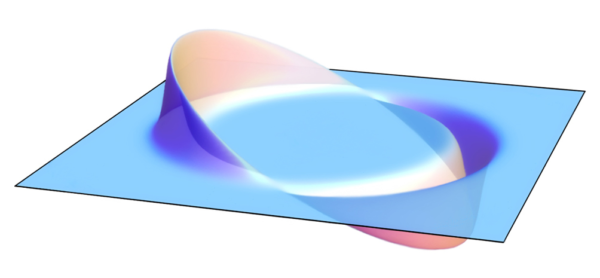 A two-dimensional projection of the Alcubierre spacetime, where space itself is shortened in front of the spacecraft and lengthened behind it. Image credit: Wikimedia Commons users AllenMcC., under a c.c.a.-s.a.-3.0 license.
A two-dimensional projection of the Alcubierre spacetime, where space itself is shortened in front of the spacecraft and lengthened behind it. Image credit: Wikimedia Commons users AllenMcC., under a c.c.a.-s.a.-3.0 license.
From eric on warp drive and relativity: "I was talking about the warp drive’s ability to create a form of absolute simultaneity. I synchronize two watches on Earth, load one up in the Enterprise, deliver it to Alpha Centauri a day later, and the two watches are still synchronized. I thought that should be theory-of-relativity impossible. But I’ll admit my thinking on this is a bit mushy, and I could easily be confused here."
You're not confused here; that's exactly what's going on! Without the ability to control spacetime's curvature like the Alcubierre drive proposes, this would be impossible. But with this solution, it doesn't violate relativity, and here's why. The thing that determines how your clock runs is both the curvature of the spacetime that you're in and your relative motion through it. In the Alcubierre solution, what happens to each of them?
- The space in front of you is severely curved (contracted); the space behind you is severely curved (rarefacted), but the space where you are is as uncurved as it is at either Earth or Alpha Centauri.
- Your relative motion through that space is also non-relativistic, or very slow compared to the speed of light, and hence your clock runs at approximately the same rate as the non-relativistic clocks on either Earth or at, say, Proxima b.
So it isn't mandatory that these clocks run at the same rate, but rather it's an artifact of the (Alcubierre) solution to General Relativity that we constructed. Without a hack like this, it would be impossible, but thanks to this, it now is possible!
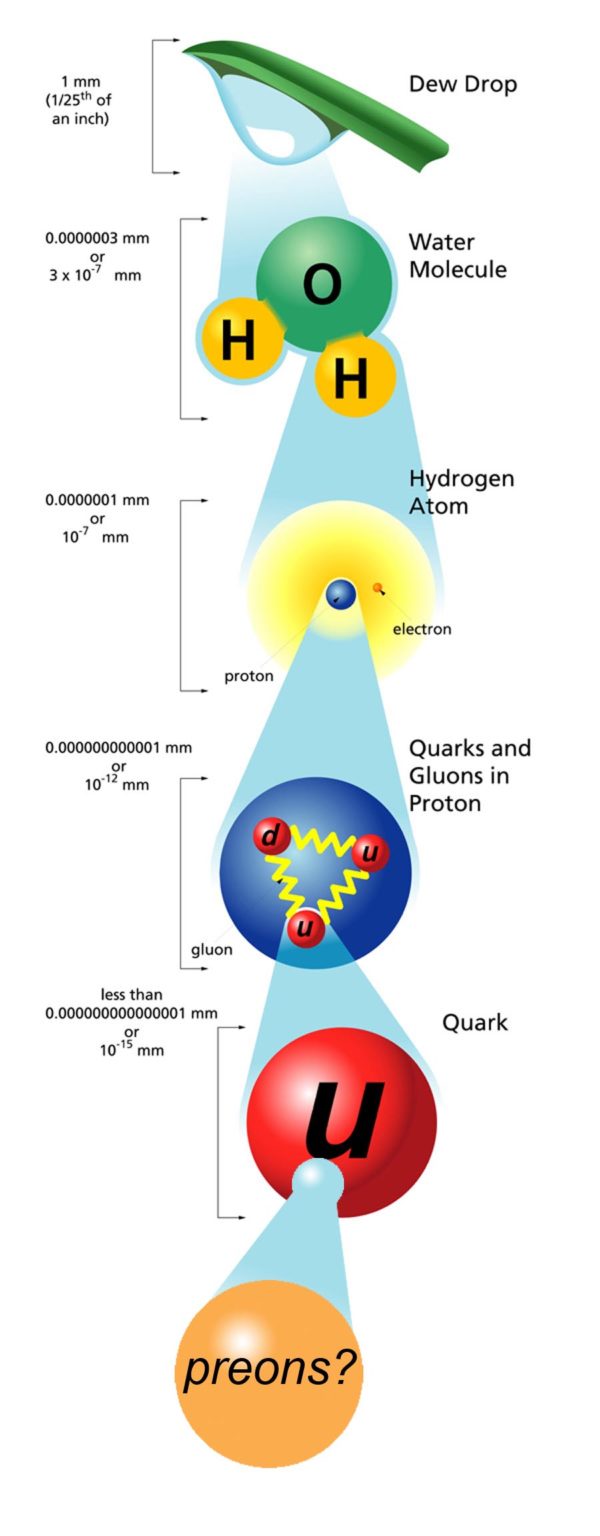 The sizes of composite and elementary particles, with possibly smaller ones lying inside what's known. Image credit: Fermilab, via http://www.fnal.gov/pub/today/archive/archive_2012/today12-03-09_Nutshe….
The sizes of composite and elementary particles, with possibly smaller ones lying inside what's known. Image credit: Fermilab, via http://www.fnal.gov/pub/today/archive/archive_2012/today12-03-09_Nutshe….
From Elle H.C. (Chelle backwards, for you clever folks) on elementary particles vs. virtual particles: "What about virtual particles, and the negative particles that make up the vacuum as in Dirac’s sea of particles?"
These are two misunderstood (by laypeople, not by physicists) ideas that have definitive relations to the particles we're used to talking about. Dirac's "negative particles" were also called "holes" in his initial theory, and they turned out to be antimatter, which is a hugely important addition to/component of the Standard Model of elementary particles.
The virtual particles alluded to, on the other hand, are not actually "particles" at all, but rather a way of quantifying the energy content of empty space in either the presence or absence of particles. This is a calculational tool for things like binding energy, and the virtual particles analogy is a way of visualizing it, but is not in any way representative of the presence of actual, physical particles.
Write it down and don't get confused again!
 A device designed to simulate a working cold fusion reaction, but that was in fact a deliberate deception. Image credit: Juan-Louis Naudin, 2003.
A device designed to simulate a working cold fusion reaction, but that was in fact a deliberate deception. Image credit: Juan-Louis Naudin, 2003.
From axil on what it takes to convince believers of unscrupulous science: "Men of science, we common people need guidance to avoid the pitfalls of faulty thinking. But mere words are not enough, actions and public experiments that confirm or deny these results are required to convince the common folk."
If only it were so easy. If you've ever heard the phrase "shifting goalposts," it is my experience that there is nothing a scientist can do to convince a true believer that cold fusion doesn't work, that perpetual motion is impossible, or even that the Earth is not flat.
I am convinced that nothing will convince you, since you would rather quote things you do not understand yourself than listen to the experts that do. And you are not unique in this, but it is depressing to think about.
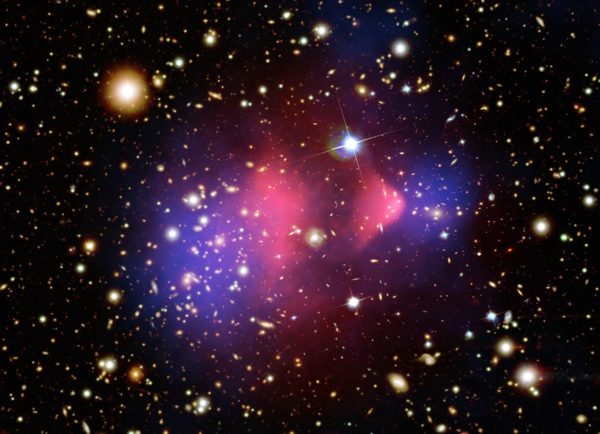 The gravitational lensing map (blue), overlayed over the optical and X-ray (pink) data of the Bullet cluster. The mismatch is undeniable. Image credit: X-ray: NASA/CXC/CfA/M.Markevitch et al.; Lensing Map: NASA/STScI; ESO WFI; Magellan/U.Arizona/D.Clowe et al.; Optical: NASA/STScI; Magellan/U.Arizona/D.Clowe et al., of the Bullet Cluster.
The gravitational lensing map (blue), overlayed over the optical and X-ray (pink) data of the Bullet cluster. The mismatch is undeniable. Image credit: X-ray: NASA/CXC/CfA/M.Markevitch et al.; Lensing Map: NASA/STScI; ESO WFI; Magellan/U.Arizona/D.Clowe et al.; Optical: NASA/STScI; Magellan/U.Arizona/D.Clowe et al., of the Bullet Cluster.
From anneb (and a good reponse is also given by Michael Kelsey) on dark matter and MOND: "The idea of dark matter was introduced to explain the rotation problem of stars in galaxies. A now less popular alternative explanation for this phenomenon is MOND. According to wikipedia, the mass of the dark matter in the Bullet Cluster can not explain away the galaxy rotation problem. The mass is a factor 10 too small, while the MOND backers claim that the dynamics of mass external to the cluster can be explained by MOND and the missing mass to explain the rotation problem is off by a factor of only two. Do MOND backers have a strong case or are they just conservatively clinging on to their old theories?"
Dark matter was taken seriously by the community because of the rotation problem of galaxies (including stars, neutral hydrogen and other tracers), first observed in the 1970s, but it was first proposed due to the motions of galaxies within clusters in the 1930s. Both MOND and dark matter can explain the problems of galaxy rotation, with MOND doing a better job. Only dark matter can explain the problems of large-scale structure formation, internal cluster motions, fluctuations in the CMB, baryon acoustic oscillations, the integrated Sachs-Wolfe effect, strong gravitational lensing, and -- as noted -- the collisions of galaxy clusters.
The only MOND backer to explain a colliding galaxy cluster was John Moffatt, whose Modified Gravity (MoG) variant theory was finely-tuned to explain the bullet cluster's distribution, but would make that same gravity-displacement prediction for two clusters that have not yet collided, which conflicts with observations. The galaxy rotation problem is still a problem for dark matter, as are most models of small-scale structure. But the MOND people miss out on explaining the entire Universe (on scales greater than maybe 1 million light years), while that's where dark matter's greatest successes are.
To answer your final question, no, MOND-backers do not have a strong case. I do not know all of their motivations for why they think MOND is right and dark matter is wrong, but the case is weak.
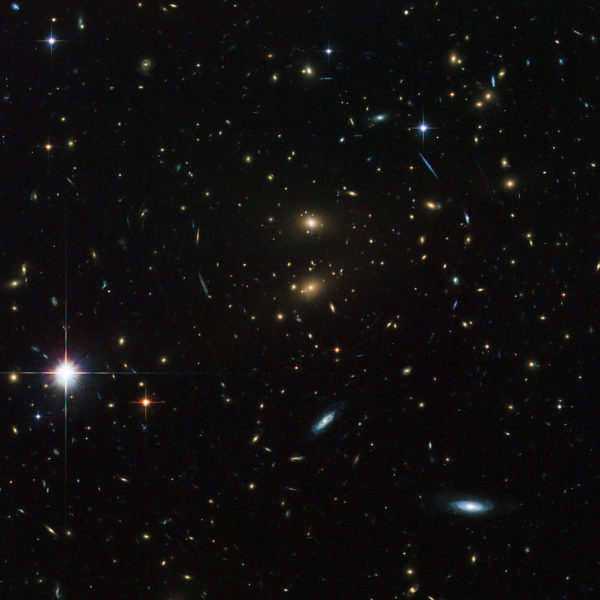 Galaxy cluster LCDCS-0829, as observed by the Hubble Space Telescope. This galaxy cluster is speeding away from us, and in only a few billion years will become unreachable, even at the speed of light. Image credit: ESA/Hubble & NASA.
Galaxy cluster LCDCS-0829, as observed by the Hubble Space Telescope. This galaxy cluster is speeding away from us, and in only a few billion years will become unreachable, even at the speed of light. Image credit: ESA/Hubble & NASA.
From lyle on making sense of the cosmic abyss: "However you do have to take as a postulate that god does not intervene directly in the current natural world."
Only to an extent. You see, there is a test of this that isn't 100% sufficient, but is necessary. You see, if you made physical observations that indicated that your laws of nature were not universal, but that there were inexplicable, acausal violations of your law, that would be evidence of some sort of intervention. We can and have looked for that evidence, and don't see it. That doesn't mean we recognize every instance (or any instance) where it actually does occur, but there is absence of evidence for intervention that we could detect.
While absence of evidence does not necessarily mean "evidence of absence," it certainly does give some credulity to that hypothesis. As eric put it -- to the hypothesis that god does intervene but that his tracks are well-covered:
Sure you can, but at that point (a) you’re no longer doing science, because you’ve set out to make your idea immune to testing, and (b) you’ve posited a somewhat stale limited deism to boot. Sagan’s dragon in the garage is not what most theologians work to defend.
Ramen.
From Omega Centauri on the south pole's wintry skies: "If you were to view from the south pole in winter, how much would the skyglow be diminished? The atmosphere above you hasn’t seen sunlight for a couple of months, so I would think most of these ions would have recombined. You still have the starlight problem (doubly so since the ground is highly reflective), but maybe the absence of skyglow makes up for that?"
My instinct is to say, cloudy, but it turns out that's only about 2/3 correct. While cloud cover during Antarctic winter is more severe than at other times of the year, it hovers around a constant 60% consistent coverage, meaning that the sky is partially visible from the ground! Interestingly enough, airglow spectrometry has been ongoing since as early as 1958 in Antarctica, and the airglow is still present throughout the winter. Could it be the circulation of the atmosphere? Could it be Earth's magnetic field funneling ions and wind particles onto the poles regardless of night-or-day?
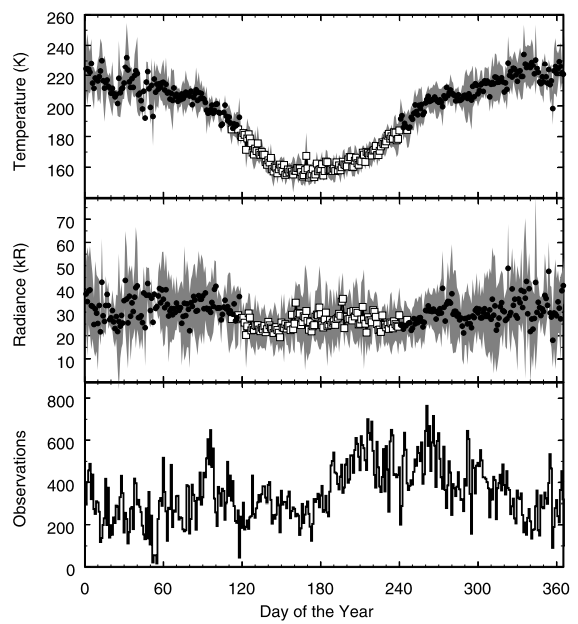 Radiance (middle) over the days of the year, collected from 1991-2002 data. Image credit: P. J. Espy, J. Stegman, P. Forkman and D. Murtagh, "Seasonal variation in the correlation of airglow temperature and emission rate," G.R.L., 34, L17802 (2007).
Radiance (middle) over the days of the year, collected from 1991-2002 data. Image credit: P. J. Espy, J. Stegman, P. Forkman and D. Murtagh, "Seasonal variation in the correlation of airglow temperature and emission rate," G.R.L., 34, L17802 (2007).
The best answer I've found is that there's a base level of "radiance" (middle graph, above) that's consistent throughout the year, but as the temperature drops during Antarctic winter, the "peaks" in radiance from variations are much lower. Why, to all of it? I'm not entirely sure, but that's mostly an artifact of me not knowing where to find the answers; not necessarily because they aren't known to humanity. Perhaps Narad's link -- to a 2010 paper by Michael Burton on Astronomy in Antarctica -- holds these answers?
Visualization of a quantum field theory calculation showing virtual particles in the quantum vacuum. Image credit: Derek Leinweber.
From Sinisa Lazarek on confusion about nothingness: "Nothingness is nothingness.. no anything. And you can’t do physics with that. So stop using the word, no matter how catchy it sounds."
This is the Antoine de Saint-Exupery solution: "Words are the source of misunderstandings." But how do we describe the origin of the Universe -- if there is an origin of the Universe -- without using a word that indicates a state without space, time, or the laws of physics? One might well coin a word like pre-singularity (or meta-singularity, if you prefer, for "beyond" a singularity) instead of nothingness, but really we're all talking about the same (no)thing. It's still not satisfying.
 The hot Big Bang resulted from the end of cosmological inflation. But that still required the existence of space, time, and a large zero-point energy. Where did all of *that* come from? Image credit: Bock et al. (2006, astro-ph/0604101); modifications by E. Siegel.
The hot Big Bang resulted from the end of cosmological inflation. But that still required the existence of space, time, and a large zero-point energy. Where did all of *that* come from? Image credit: Bock et al. (2006, astro-ph/0604101); modifications by E. Siegel.
From Naked Bunny with a Whip on taking the semantics of nothingness a little further: "My issue with the question why there’s something instead of nothing (the philosophical “true nothing”) is that it assumes “nothing” is a valid state, as though “something” and “nothing” are just flip sides of the same coin. Like Ethan mentions in his article, I’m not convinced that’s it’s even meaningful, since a state is, itself, arguably “something”."
We run into problems all the time when we apply what we've learned about one experience to a situation completely outside that experience. Has what we've learned about anything and everything prepared us to intelligently converse about philosophical nothingness? I would argue "no," and yet here I am trying anyway. Alas.
From axil on his view of a LENR future: "It will soon become apparent that installing a LENR power unit inside the home or car will not be possible. The muon bubble emanating from a home LENR reactor will take down all the electronic equipment inside the home and this EMI interference will not be mitigated through EMI shielding. Many of the LENR faithful will be disappointed that their dreams of off the grid existence will be dashed."
Above is Andrea Rossi during a "demonstration" of his cold fusion/LENR device back in 2010-2011. With him in direct contact with the alleged fusion apparatus. He clearly died of radiation poisoning and all the electronic equipment clearly malfunctioned, due to this radiation which was totally unshielded. Right?
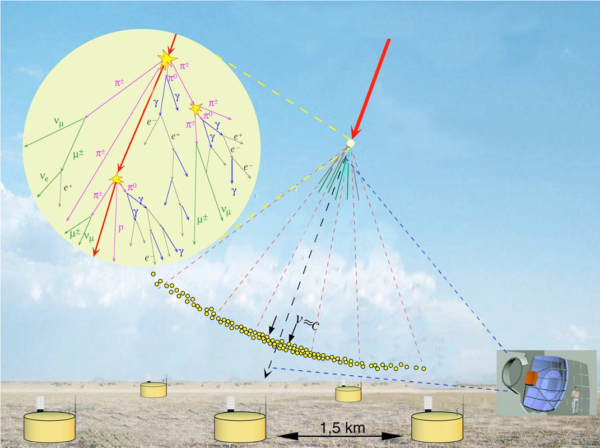 The production of a cosmic ray shower, produced by an incredibly energetic particle from far outside our Solar System. Image credit: Pierre Auger Observatory, via http://apcauger.in2p3.fr/Public/Presentation/.
The production of a cosmic ray shower, produced by an incredibly energetic particle from far outside our Solar System. Image credit: Pierre Auger Observatory, via http://apcauger.in2p3.fr/Public/Presentation/.
From Frank on cosmic ray-catalyzed muonic hydrogen: "Surface of Earth is constantly bombarded by Muons created by Cosmic Rays. I think Cold Fusion maybe actually Muon-catalyzed fusion and the reason why labs around the World failed to replicate Fleischmann–Pons experiment maybe that they all done the experiment inside radiation shielding (to get “clean” measurements) which actually prevented Muons coming in."
The muons are too fast to form stable muonic hydrogen atoms; the energy levels are too high. The flux is also way too low. Hold your hand out so that it's parallel to the ground.
Now wait 1 second.
There. One muon from cosmic rays just passed through your hand. Was it worth it? Can we power the world with that energy? No? Oh well. Also, you need a tremendous amount of shielding to stop a muon; get underground through about a kilometer of Earth and then we'll talk.
From Michael Kelsey on the cleanness of hot fusion: "A very minor nit-pick, but one which fusion energy boosters often fall into. You wrote, “fusion power is clean [and] produces no radioactive waste…” That is not necessarily true for the kind of fusion we have to do on Earth: instead of the solar p-p reaction, which produces helium, neutrinos, and gamma rays (heat), we have to use deuterium-tritium.
D-T fusion produces helium, heat, plus one neutron. That neutron bounces around all of the hardware of whatever you’re using as your fusion chamber, and eventually gets absorbed by some nucleus. That nucleus becomes radioactive. If we ever produce a nice, self-sustaining power-plant, it’s going to end up brittle and radioactive within a “few” years.
The ITER project includes an entire sacrificial layer of lithium lining the fusion chamber. The idea is that lithium-6 (stable) absorbs slow neutrons, becoming Li-7, which is also stable. Some of the reactions with Li-6 will cause the nucleus to break up, releasing tritium and deuterium or tritium and an alpha (helium)."
This is different from the fusion that takes place in the Sun, which has deuterium-helium-3 fusion as a stage (producing a proton and He-4), rather than deuterium-tritium fusion. Tritium itself is radioactive, and the D-T reaction produces He-4 and a neutron; neutron capture is problematic! So yes, you need something absorptive around the reactor to catch the neutron if you're using a D-T reactor, which many (but not all!) fusion reactors do. Perhaps that will someday be the tipping point between Inertial Confinement Fusion (ICF) and magnetized plasma fusion: that most ICF relies on pure hydrogen!
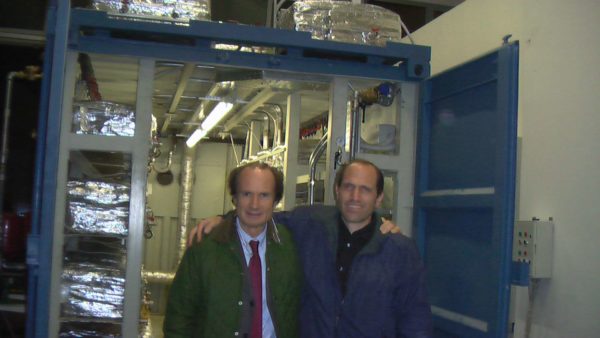 Andrea Rossi and Sterling Allan, during a 2011 demonstration of the E-Cat. Image credit: Sterling D. Allan with Hank Mills of Pure Energy Systems News. Via http://pesn.com/2011/10/28/9501940_1_MW_E-Cat_Test_Successful/.
Andrea Rossi and Sterling Allan, during a 2011 demonstration of the E-Cat. Image credit: Sterling D. Allan with Hank Mills of Pure Energy Systems News. Via http://pesn.com/2011/10/28/9501940_1_MW_E-Cat_Test_Successful/.
And finally, from PJ on why we're still at it: "Thought we gave this topic a good hammering last time around."
You know what irks me the most about this topic? I've written about it, publicly, for five years now, and how it's obviously a combination of incompetence and fraud. The thing is, do you know how many LENR researchers have come forward to me and said, "I have met the scientific criteria you laid out. I have an experiment you can perform and results you can reproduce that demonstrate that LENR is happening. Just do this thing "A" and you will see this result "B" that proves it."
The answer is zero. And the answer is zero because the number of scientifically valid LENR experiments is zero. When I get something wrong about science on the internet (it happens! I'm not perfect! Whaaaat?!), it's the actual scientists who come and correct me. And they point me to quality work that I can check for myself, and then I change my tune to the correct tune. But there are only sycophants and hangers-on who chide me about cold fusion. Why is that? Why no scientists? Why no one with an independently reproducible experiment?
Is it because they're really sitting on the Earth-saving, trillion-dollar secret that's going to change humanity, but everyone who's stumbled upon the secret is too greedy to make the secret public? Or is it because they don't have the thing they say they have, and they know if they let real scientists in on what they're actually doing, they'll be exposed for the frauds they are? I'll let you decide, but keep this in mind: you may not have the skills to make the right decision. As John Cleese so deftly put it:



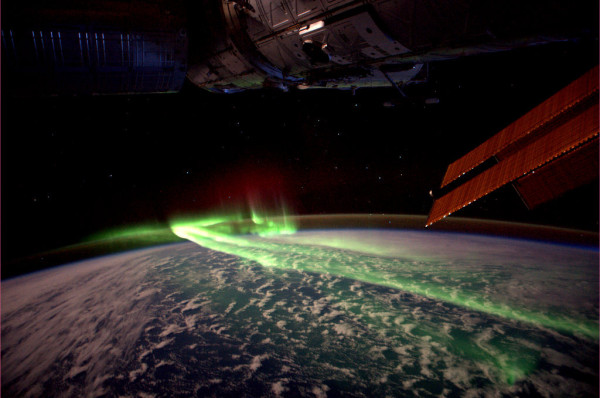
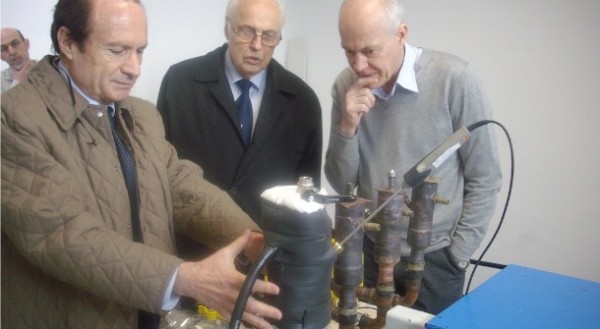
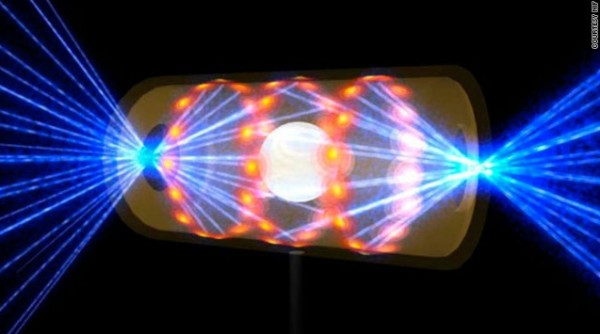
I can't speak for others, but yes, I would be interested.
@Ethan: I second dean's vote. I am not an astrophysicist, let alone an astronomer, so having a tutorial on how the classifications originated would be very interesting!
If I may free-associate some more, I really miss Virginia Trimble's annual Ap'XX entries, even if the OCR'd manuscripts were uniformly assigned to the wrong comma jockeys.
Me three.
:+1:
I haven't kept up with inertial fusion, but it suffers from the same challenge as magnetically confined fusion, creating and maintaining the target fuel at sufficiently high combination of temperature, pressure and time to get enough fusion to happen. So the easiest reaction is chosen, which is DT. Now inertial fusion is much shorter but a much higher pressure/density as the magnetically confined variant, but I don't think proton on proton fusion is being contemplated.
@Ethan,
”Dirac’s “negative particles” were also called “holes” in his initial theory, and they turned out to be antimatter”
No.
The Dirac sea is a theoretical model of the vacuum as an infinite sea of particles with negative energy. The positron, the antimatter counterpart of the electron, was originally conceived of as a hole in the Dirac sea”
https://en.wikipedia.org/wiki/Dirac_sea
@Ethan
"But how do we describe the origin of the Universe — if there is an origin of the Universe — without using a word that indicates a state without space, time, or the laws of physics?"
But are we really talking about a state without space and things? Even in pre-inflation age, space is a given. Space and a field (in the most simple model). And that field has some energy density... enough to unify all the forces. And it sits there.. those are the initial conditions, we have space (and time...altough probably meaningless), and a thing (or things) in it. Then the field undergoes a change... inflation starts etc.. Am not sure to which singularity you reffer, as there are none present in current state of the theory.
It's true that the picture above is not our universe, and it's doesn't have any particles in it. But it's not nothing. You have at least 3 elements with which to operate.. thus hardly no(thing). That was my argument. The word "nothing" as useful as it is, IMO really has no place here. Because the model that we all believe in clearly says... In the beginning there was a field, and that field was in some space, but things clearly weren't all good, because then something happened :D
It is nice to bash the crooks of LENr trying to exploit the dissonance between the clear reality of LENR in the lab, for who can read calorimetry papers, and the denial by the physicist community.
I just notice that you dis not show the much more serious looking experiuments of Iwamura and the replication by takahasji.
nor the cell of McKubre, the preprint of Oriani paper, the cells of Miles, the cells that are tester in SKINR labs, in ENEA.
nor the co-deposition cells tester in spawar.
Di you just read the particle cited in Current science LENR special issue ?
especially about He4 and heat correlation ?
do you judge that when nature rejected the ENEA report 42 writtent by DeNinno, it was faire to say "we have no room".
do you think that when Oriani paper was positively peer reviewed, answering to the (later refuted) critics of Lewis and Hansen, the editor was right to dump the paper ?
Do you thing that when science refused to publish the solid critics agains Caltech paper, it was good practice ?
Do you support the incredible claims by morrison ? and reject the answers of Fleischmann ?
Dis you just read the book of Charle Beaudette, excess Heat, or if you don't trust his opinion, at least you read the article he cites ?
Are you just understanding of what I talk about ?
before having an opinion and exploiting your influence, it would be nice you document more.
You clear seems to focus too much on theory, too much on physics, with too few consideration for history, of chemistry, of epistemology.
just start to read about the beginning of semiconductors, in the 20s, and the early industrialisation.
What did Pauli said on those questions ?
If you cannot find the preprint of Oriani's article, dumped by Science, ask the grapevine (maybe Oriani will answer).
You can also ask for the incoming EmDrive paper... the grapevine is well informed. but does it trust you?
I'm with #1, #2 and #4 on an article about Annie Jump Cannon.
I'm a Patreon of yours if that helps. :-)
Containing Tritium is also highly problematic. It won't be contained. It's too small.
Worse, it looks like hydrogen to body chemistry and will be taken up in, for example, water, but it doesn't have the same fine structure and therefore its binding will be wrong.
And then it decays with a fairly damaging source of radiation right where it's going to do no good (your body interior) and will also leave your body without hydrogen where it expected it.
Dean: "I can’t speak for others, but yes, I would be interested"
It's in the new Cosmos if you want to watch it on the TV screen.
None of which are proof of physical reality.
Getting something wrong somewhere doesn't mean cold fusion exists.
Yes.
https://en.wikipedia.org/wiki/Positron
@Wow,
Read the quote to which Ethan responded, and see the mistake:
"the negative particles that make up the vacuum as in Dirac’s sea of particles?"
BTW an electron is already negative, so a positron is ...
#Chelle #14: Your on-going ignorance is truly a monument for the ages. The sign of a particle's electric charge is uncorrelated with the sign of it's energy content. In Dirac's model, protons with positive electric charge have positive energy, and electrons with negative electric charge also have positive energy. Furthermore, photons, with zero electric charge, also have positive energy.
Don't try telling that to Gordon Kane.
P.S. Has a fresh prediction for the gluino mass been issued this year?
@Narad#156
A good and quite comprehensive explanation on what virrtual particles are and what they are not can be found on Prof Matt Strassler’s mostly dormant blog here: - Matt Strassler – Virtual particles.
Strassler’s explanation doesn’t seem to tie in all that well with Gordon Kane’s article.
That didn't work out terribly well. Here's the link:
https://profmattstrassler.com/articles-and-posts/particle-physics-basic…
@Alan L.: I'm familiar with it, thanks, but it's just as well to have it presented for contrast. (The P.S. was meant as a mild Kane barb.)
I wrote the book, "Energy, Cold Fusion, and Antigravity. It's at Amazon and Barns and Noble.
Frank Znidarsic
When I was an undergraduate, I created a (IMHO) web of interlocked rubber bands and decorative baby squash on the ceiling of my hard-earned, prime real estate, dorm room. Sadly, it's no longer available anywhere.
^ "(IMHO) amazing," that is.
@Michael Kelsey #15
"This "hole" (positron) in the sea of negative-energy electrons would respond to electric fields as though it were a positively charged particle." - https://en.wikipedia.org/wiki/Positron
@Chelle #23: Your point? This is what I do for a living (BaBar 1996-2008, ATLAS 2008-2010, SuperCDMS 2009-present). Don't teach your grandmother to suck eggs.
@Michael Keley #24
I wasn't planning to teach you anything. I was just pointing out that the 'hole in the sea of negative particles' was the positron and considered a positively charged particle; and that these holes weren't “negative particles” like Ethan wrote.
But than again I am probably wrong and mixing up things ...
Chelle @25: Michael's explanation @15 is pretty much all you need to know to get it right. Why you won't accept that explanation, I have no idea.
There are multiple meanings of the word "positive." You're focusing on one, but it isn't the right one for this discussion. For instance, I'm positive that what Ethan is discussing has nothing to do with positive vs negative electromagnetic charge, and your insistence that it does is positively annoying.
Holy hell. I hope you got someone to edit your book before you published it.
"Read the quote to which Ethan responded,"
I did.
" and see the mistake:"
There wasn't one.
"Chelle @25: Michael’s explanation @15 is pretty much all you need to know to get it right. Why you won’t accept that explanation, I have no idea."
Chelle's entire reason for living depends on scientists being wrong and chelle being right.
That's why.
Nobody said it was a SANE reason.